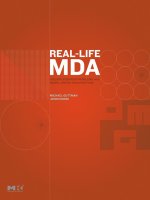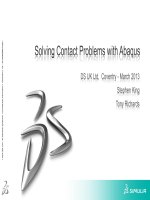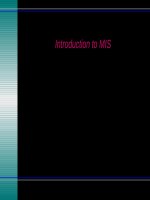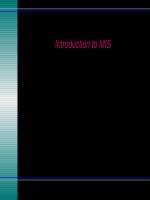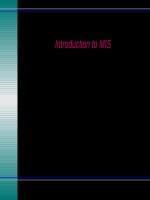Lecture Management information systems: Solving business problems with information technology – Chapter 2
Bạn đang xem bản rút gọn của tài liệu. Xem và tải ngay bản đầy đủ của tài liệu tại đây (2.18 MB, 53 trang )
Introduction to MIS
Chapter 2
Information Technology Foundations
Copyright © 1998-2002 by Jerry Post
Introduction to MIS
1
Personal Productivity
Introduction to MIS
2
Outline
Types of Data
Trends
Hardware Components
Operating Systems
Business Tasks
Application Software
Operating Systems
Cases: Entrepreneurial Business
Appendix: Displaying Data
Introduction to MIS
3
Trends
Hardware
Software and Operating System Trends
Size (capacity)
Speed (performance)
Reliability
Data Types
Original:
Early:
Easier:
Current:
Introduction to MIS
User/Programmer
Sequential Questions
Menus
User/Event Driven
4
Technology Trends
Cost of workers increasing
Cost of technology decreasing
Capabilities increasing
Processing speed
Storage capacity
Types of data
text
image
sound
video
Quality and reliability
Communications
Introduction to MIS
5
Brief History of Computing
Forerunners
Atanasoff Berry Computer
ENIAC electronic digital computer
EDSAC stored program computer
1951
1954
UNIVAC I: U.S. Bureau of Census
IBM 650: popular 1st generation
1960
1942
1946
1949
1950
Pascal's mechanical adding machine
Leibnitz' calculator
Industrial Revolution in England
Babbage's analytical engine
Hollerith's punched-card system
1940
1642
1694
1750
1834
1880
1965
1965
Introduction to MIS
IBM System/360: 3rd generation
DEC PDP-8: 1st minicomputer
6
Computing History
1970
IBM Personal Computer
Apple Macintosh
32 bit microprocessors (I486 & M 68040)
RISC processors, LANs
Rapidly declining cost of small computers
Software integration
The Internet
2000
1982
1984
1988
1989
1990
IBM System/370 announced
MITS Altair 8800: micro kit
Cray I shipped supercomputer
TRS-80/I, Apple II introduced
1980
1970
1975
1976
1978
Ubiquitous computing
Speech recognition
Introduction to MIS
7
Data Types
Input
Numbers
Text
Process
000001100
000001000
--------------000010100
12 + 8 = 20
This is a test
84 104 73 115 …
Output
20
This is a test
0010000000000000000
0100000000000001001
0110000011000011011
0111111111111001111
1111111111111011111
1111111111100011111
Images
pitch or
volume
Time
Sound
8905…
000001000 000001001 000010100 …
Video
Introduction to MIS
00101010111
11010101010
01010101010
11110100011
00101011011
00101010111
11010101010
01010101010
11110100011
00101011011
00101010111
11010101010
01010101010
11110100011
00101011011
00101010111
11010101010
01010101010
11110100011
00101011011
00101010111
11010101010
01010101010
11110100011
00101011011
8
Application Objects
Primary Objects
Primary Functions
Text
Numbers
Pictures
Sound
Video
Object
Attributes
All
Cut
Copy
Paste
Edit
Save and Retrieve
Align
Functions
Cut, copy, paste, edit, save,
retrieve, align.
Numbers
Precision, scale.
Total, calculate, compare.
Text
Typeface, size, bold, italic, etc.
Search, format, spellcheck.
Image
Resolution, number of colors
bitmap or vector.
Color and light changes
rescale, rotate, blend, etc.
Sound
Sample rate, frequency & amplitude,
MIDI or sample.
Record, playback, frequency and
amplitude shifts.
Video
Inherit image and sound attributes
and functions, frames per second.
Record, playback
compress and decompress.
Introduction to MIS
9
Application Objects: Numbers
Numbers
Attributes
Precision
Display format
Precision
Value limits
Functions
Computations
Aggregation
Sorting
Comparisons
5.563
0.354
+ 6.864
12.781
Round off
before add
5.56
0.35
+ 6.86
12.77
Yes
Is the display
precision the same as
the computation
precision?
Internal data formats
Spreadsheet:
=Round(5.563,2)
Introduction to MIS
No
decimal places
Integer -32,768 to 32767
0
Float
7
+/- 3.4 x 10 38
Double +/- 1.797 x 10 308
Round off
after add
5.56
0.35
+ 6.86
12.78
15
10
Application Objects: Text
Text
Typeface Classification
Attributes
Typeface
Point size
Color
Bold, italic
Underline . . .
Sans serif
Courier 18 (monospace)
Serif
Functions
Arial 20
Garamond 24
New Century Schoolbook 16
Times 22
Spelling
Grammar
Searching
Sorting
Ornamental
Braggadocio 18
Brush Script 20
leading
72 points,
1 inch
Introduction to MIS
A
11
300 dpi scan
Introduction to MIS
Sample Bitmap: Bryce Canyon
Bitmap file: 2,245,008 bytes
PNG bitmap: 435,575 bytes
12
Sample Vector Image
Stored internally as mathematical objects:
Lines
Points
Rectangles
Circles
Introduction to MIS
WMF: Windows Meta File
12,430 bytes
13
Bitmap Images: Adobe Photoshop
Emboss
(1) Set a light source.
(2) Twirl.
Hundreds of tools and options.
You can add and delete items from photographs.
Professional editing is hard to detect.
You need a really good monitor to edit photos.
Introduction to MIS
14
Audio: Cakewalk MIDI
MIDI editors
provide
complex editing
tools for music.
You can assign
instruments,
set musical
features, even
edit individual
notes.
Entire piece (1:39): 17,441 bytes
Introduction to MIS
15
Audio capture: Cakewalk
When you capture
audio, you can edit it.
Detailed options exist
to match conventional
audio studio facilities.
Or you can edit
individual samples.
CD quality audio (44.1 KHz, stereo): 150 KB/sec or 9 MB/min
(6 MB/min compressed)
Introduction to MIS
16
Video: Adobe Premiere
Video capture
or animation
Transition
Video overlay
Superimpose text
Superimpose text
Audio (2 channels)
with volume fade.
NTSC Video, full screen, 30 fps: 3 MB/sec (compressed)
Introduction to MIS
17
Application Objects
Pictures & Video
Attributes
Sound
Size & resolution
Colors
Functions
Attributes
Display/Play
Edit
Functions
Image Pac
Base/16
Base/4
Base
Base*4
Base*16
Base*64
Introduction to MIS
Photo-CD Resolutions
Name
Resolution (v x h)
Thumbnail
128 x 192
Thumbnail
256 x 384
TV
512 x 768
HDTV
1024 x 1536
Digital Print
2048 x 3072
Pro
4096 x 6144
Amplitude/volume
Frequency/pitch
MIDI v samples
Record
Play
dpi at 3 x 5
40
80
160
300
600
1200x
18
Size Complications
Video presents the most problems:
Full screen (640 x 480), 24-bit color.
Requires hardware compression/decompression (codec).
Capturing full-screen video requires ultra-fast computer.
Older drive systems cannot transfer data fast enough.
Full-screen video with compression fills up 2 GB in 10 minutes.
Introduction to MIS
19
Virtual Reality
Hardware
Output
Input
VR Glove
Pressure suits
Software
3-D video
Goggles
3-D sound
Limited resolution/speed
Limited business applications
Potential
Introduction to MIS
20
Virtual Reality Photo
Workers at LISITT (Laboratorio Integrado de Sistemas Inteligentes y Tecnologias
de la informacion en Trafico) have developed a virtual reality driving simulator
(SIRCA) to evaluate driver learning and road safety.
Introduction to MIS
21
Computer Components
Input
Process
Output
seconds - milliseconds
nanoseconds
• Processor
• RAM
• Device controllers
seconds - milliseconds
• Video monitor
• Printer
• Plotter
• Process control
• Voice output
Secondary
• Music synthesizers
storage
milliseconds • Other computers
• Magnetic Disk
• Floppy Disk
• Optical Disk
• Tape Drive
• Keyboard
• Mouse
• Optical scanner
• Voice input
• Bar code
• Touch screen
• Light pen
• MICR
• Magnetic strips
• Card reader
• Other computers
Introduction to MIS
22
0
Introduction to MIS
P/III-550
P/III-450
P/II-400
P/II-333
P/II-266
P/Pro-200
P/MMX-233
P/MMX-200
P/MMX-166
P-166
P-133
P-100
P-75
P-60
486DX-50
486DX-33
486DX-25
486SX-20
386SX-25
Intel Microprocessor Speeds
Intel iCom p2 Rating
800
700
600
500
400
300
200
100
23
Intel Processor Speeds by Year
Intel Processor Performance
4.00
3.50
3.00
2.50
2.00
1.50
1.00
0.50
0.00
1989
1990
1991
1992
386DX- 486DX- 486DX- 486
33
25
33
DX2-66
Introduction to MIS
1993
1994
1995
1996
1997
1998
1999
2000
2001
P-60
P-100
P-166 P/MMX- P/II-300 P/II-450 P/III-550 P/III-1G P/4/2.0
200
24
Speed and Cost
Floating Point Operations Per Second
Approximate Cost per MegaFLOPS
70000
60000
50000
40000
30000
20000
Super
Midrange
Micro
10000
0
1990
1995
1998
1998
Conclusion:
By 1998, processing time
was free.
Introduction to MIS
Computer
$/MFLOPS
Micro/PII-300D
$17
Midrange/Alpha
67
Super/SGI
8
Cost MFLOPS
$3,000
170
10,000
150
500,000
60,000
25

